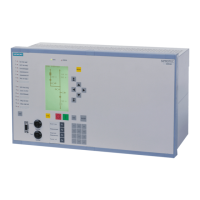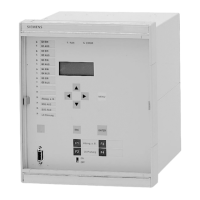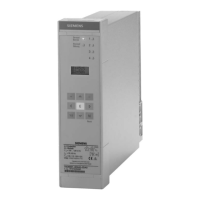Functions
2.25 Function Control and Circuit Breaker Test
SIPROTEC, 7SD5, Manual
C53000-G1176-C169-5, Release date 02.2011
452
External functions may be controlled by this indication via an output contact. Examples are:
• Automatic reclose devices,
• Channel boost in conjunction with signal transmission by PLC.
• Further additional devices or similar.
Spontaneous Indications
Spontaneous indications are fault indications which appear in the display automatically following a general fault
detection or trip command of the device. For the 7SD5, these indications include:
„Relay PICKUP“: Protection function that picked up;
„S/E/F TRIP“: Protection function which tripped (only device with graphical display);
„PU Time“: Operating time from the general pickup to the dropout of the device, in ms;
„TRIP Time“: the operating time from general pickup to the first trip command of the
device, in ms;
„dist =“: Distance to fault in kilometers or miles derived by the distance to fault locator
function (if possible).
2.25.1.5 Tripping Logic of the Entire Device
Three-pole tripping
In general, the device trips three-pole in the event of a fault. Depending on the version ordered (see Section
A.1, „Ordering Information“), single-pole tripping is also possible. If, in general, single-pole tripping is not pos-
sible or desired, the output function „Relay TRIP“ is used for the trip command output to the circuit breaker.
In these cases, the following sections regarding single-pole tripping are not of interest.
Single-pole tripping
Single-pole tripping only makes sense on overhead lines on which automatic reclosure is to be carried out and
where the circuit breakers at both ends of the line are capable of single-pole tripping. Single-pole tripping of the
faulted phase with subsequent reclosure is then possible for single phase faults; three-pole tripping is generally
performed in case of two-phase or three-phase faults with and without earth.
Device prerequisites for phase segregated tripping are:
• Phase segregated tripping is provided by the device (according to the ordering code);
• The tripping function is suitable for pole-segregated tripping (for example, not for frequency protection, ov-
ervoltage protection or overload protection),
• The binary input „>1p Trip Perm“ is configured and activated or the internal automatic reclosure function
is ready for reclosure after single-pole tripping.
In all other cases tripping is always three-pole. The binary input „>1p Trip Perm“ is the logic inversion of a
three-pole coupling and activated by an external auto-reclosure device as long as this is ready for a single-pole
auto-reclosure cycle.
With the 7SD5, it is also possible to trip three-pole when only one phase is subjected to the trip conditions, but
more than one phase indicates a fault detection. This can be the case, for instance, when two faults at different
locations occur simultaneously, but only one of them is within the range of the differential protection or, in the
case of distance protection, within the fast tripping zone (Z1 or Z1B). This is selected with the setting parameter
3pole coupling (address 1155), which can be set to with PICKUP (every multiple-phase fault detection
causes three-pole trip) or with TRIP (in the event of multiple-phase trip conditions, the tripping is always
three-pole).

